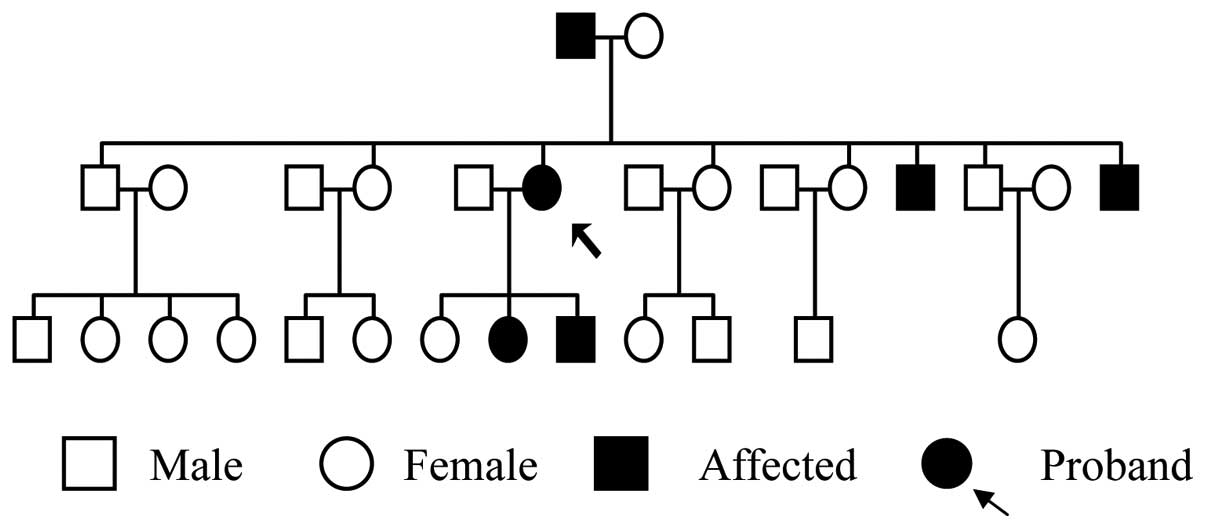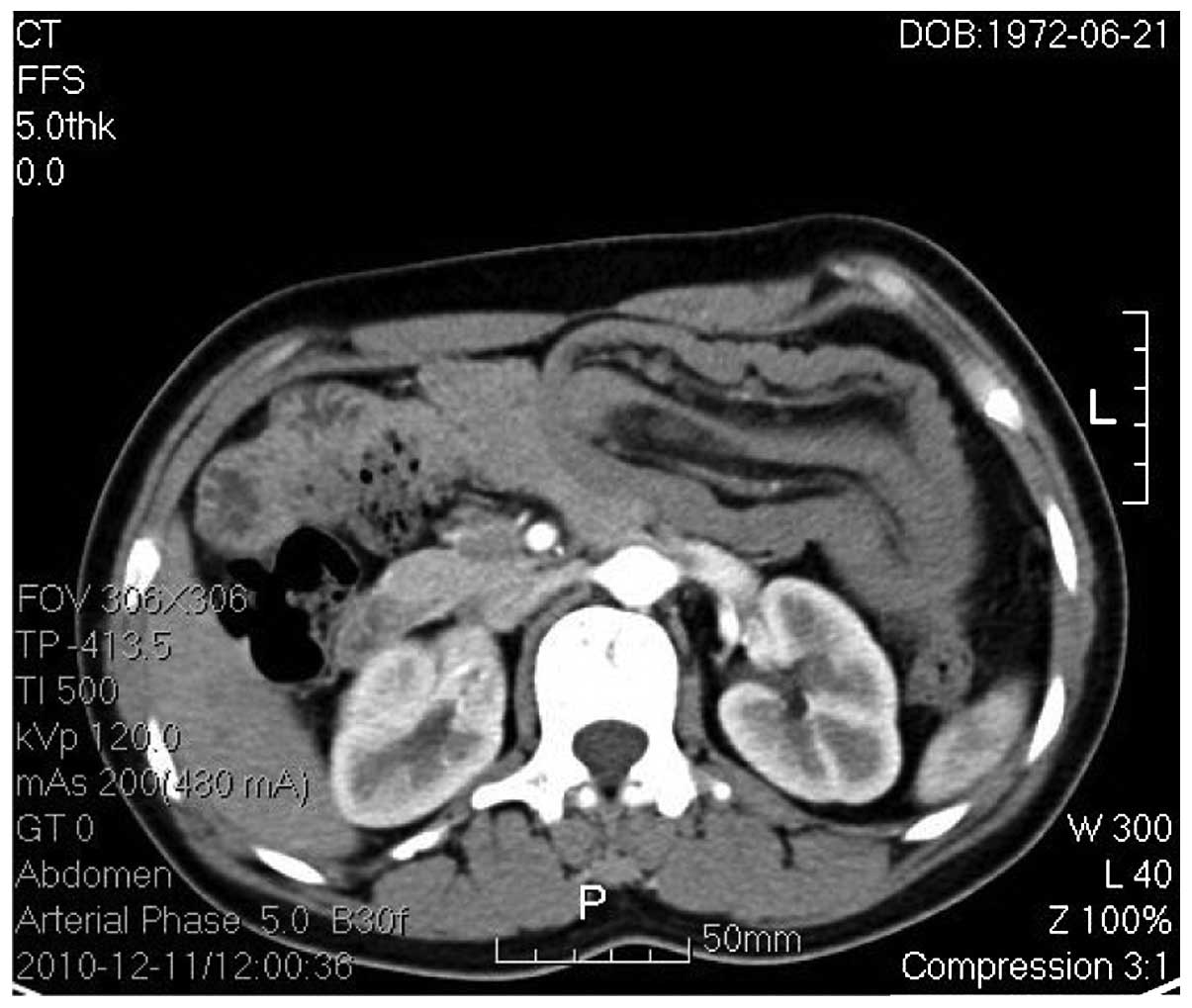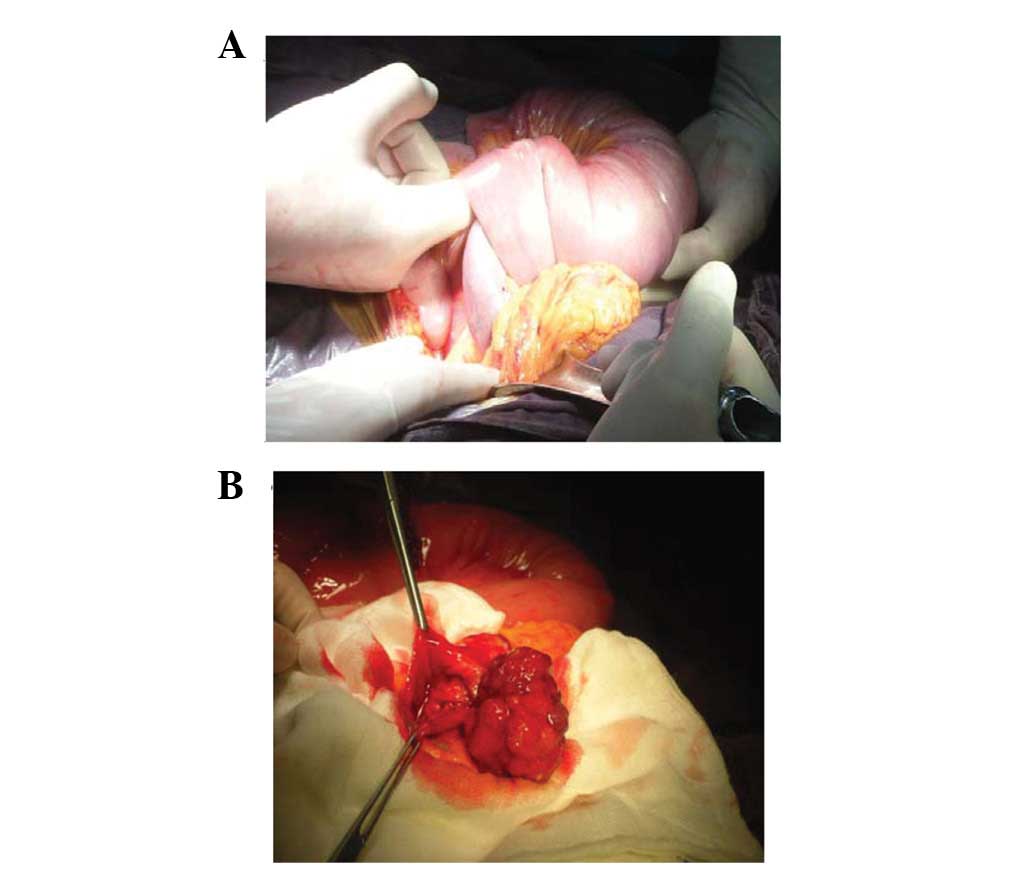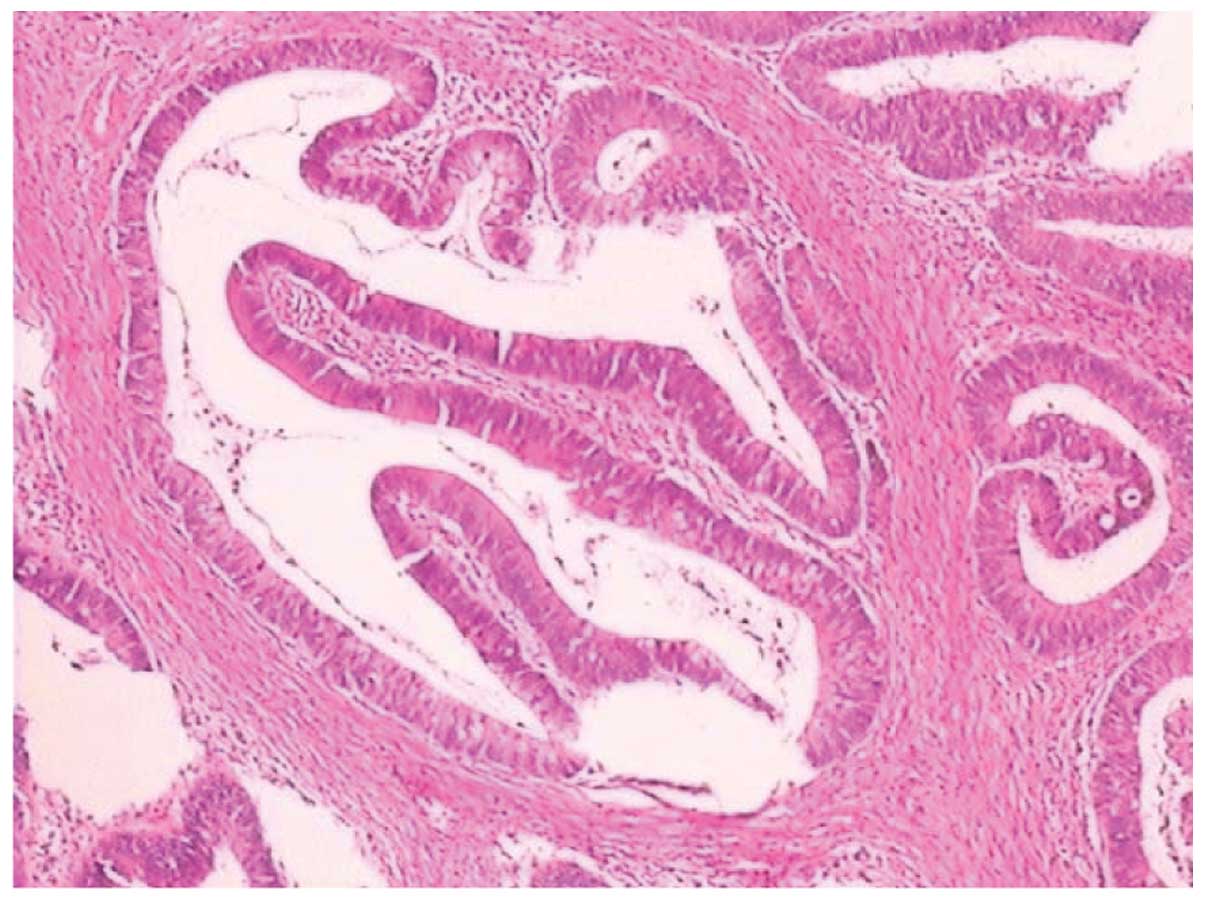Introduction
Peutz-Jeghers syndrome is a rare autosomal dominant
hereditary disease. It characterized by hyperpigmented macules and
gastrointestinal polyps, the majority of which are hamartomas. It
was once thought that in patients with Peutz-Jeghers syndrome there
is a lower incidence of the transformation from hamartoma to
malignance. However, increasing evidence indicates that these
patients are not only at a higher risk of transformation to
malignant polyps, but also of benign and malignant tumors in other
organs throughout the body (1).
Thus far, cases of intussusception and polyps occurring in
different parts of the intestine and with different types of
malignancy at the same time has rarely been reported.
Case report
A 38-year-old female presented at the outpatient
department of the Second Affiliated Hospital of Zhejiang University
College of Medicine, China, with a history of recurrent abdominal
pain of 10 years’ duration and increased pain with vomiting for
approximately 1 month. The patient described the pain as
sudden-onset colic, and after diarrhea the feeling of pain would be
relieved. A physical examination revealed hyperpigmented macules on
her lips, buccal mucosa, the tips of fingers and toes, palms and
soles of her feet (Fig. 1). The
patient’s father, her two younger brothers, one son and one
daughter had experienced similar complaints (Fig. 2). Clear evidence of intestinal
peristalsis in the left upper abdomen was observed when she
experienced abdominal pain. Bowel sounds were increased. Laboratory
investigations revealed normal hemoglobin, blood count and liver
and renal function. Her erect abdominal radiograph did not reveal
air-fluid levels. Breast ultrasonography showed fibroadenoma, and
gynecological ultrasound showed ovarian cysts. E-colonoscopy showed
multiple polyps within the colon, of which three were relatively
large, in the transverse colon, descending colon and sigmoid colon.
A diagnosis of Peutz-Jeghers syndrome was considered on the basis
of clinical examination and the E-colonoscopy, and the patient
underwent abdominal computed tomography (CT). Contrast-enhanced
abdominal CT showed that part of the intestine in the left upper
abdomen with the surrounding mesenteric fat and vessels were
invaginated into another section of the intestine (Fig. 3). A laparotomy revealed the part of
the proximal jejunum, 20 cm away from the Treitz ligament,
invaginated into the proximal jejunum, which determined the
diagnosis of intussusception. A polyp was observed at the leading
point of the intussusception. Following the removal of the
intussusception, this polyp was completely resected (Fig. 4). The three larger polyps described
previously were also completely resected. However, frozen section
pathological diagnosis revealed hamartomas in the transverse colon,
malignant hamartoma in the small intestine and descending colon,
and mucinous adenocarcinoma infiltrating to the muscularis in the
sigmoid colon (Fig. 5). Therefore,
the method of surgery was altered to perform partial resection of
the small intestine and left hemicolectomy. The patient was
discharged 10 days after surgery. The histopathological examination
following surgery supported the frozen section pathological
diagnosis. Currently, the condition of the patient is stable and
she remains in good health. Follow-up of the patient is
ongoing.
Discussion
Peutz-Jeghers syndrome is a hereditary disease
characterized as autosomal dominant. It was first described by
Peutz (2) in 1921 and Jeghers et
al(3) in 1949. The incidence
has been estimated to be one in 200,000 births (4). Autosomal dominant inheritance,
mucocutaneous pigmentation and hamartomatous polyps of the
gastrointestinal tract are the three main features of Peutz-Jeghers
syndrome. The most commonly affected sites of Peutz-Jeghers polyps
in the gastrointestinal tract are the jejunum, colorectal region,
duodenum and stomach, in decreasing frequency. The most common
histological type of polyps is hamartoma, which demonstrates
epithelial elements in the submucosa, muscularis propria and
subserosa, and they frequently surround mucin-filled spaces
(5). Peutz-Jeghers syndrome is a
tumor susceptibility syndrome. The incidence of tumors in
Peutz-Jeghers syndrome patients is 15 times higher than in normal
individuals, and the incidence of malignant tumors is up to 20%
(6). It is not only the hamartomas
themselves that can evolve into adenomas and carcinomas, but also
malignant tumors of other organs outside the gastrointestinal
tract, occurring via de novo pathways (7). The cause of Peutz-Jeghers syndrome
appears to be a germline mutation of the STK11/LKB1
(serine/threonine kinase 11) tumor suppressor gene in most cases
(8,9). In addition, the polyps with malignance
may be associated with the interferon-induced transmembrane
glycoprotein-1 (IFITM-1) (10),
which may be a good marker to test for polyps in the process of
malignant transformation in Peutz-Jeghers syndrome patients. The
major therapeutic strategy used for Peutz-Jeghers syndrome is
nonsteroidal anti-inflammatory drugs (NSAIDs). In addition, Wei
et al(11) confirmed that
rapamycin inhibited the enzyme encoded by STK11, which inhibited
the growth of hamartoma. The indications for surgical treatments
include patent polyps with abdominal cramps, intestinal bleeding,
intussusception, intestinal obstruction and malignant polyps
confirmed by endoscopic biopsy. The combination of surgical and
endoscopic polypectomy is an efficient and practical choice in the
management of polyps in patients with Peutz-Jeghers syndrome
(12). Radical surgery is required
only if the polyps are confirmed to be malignant. To date, cases of
intestinal intussusception combined with multiple different types
of malignant polyps have rarely been reported.
References
|
1
|
Niimi K, Tomoda H, Furusawa M, et al:
Peutz-Jeghers syndrome associated with adenocarcinoma of the cecum
and focal carcinoma in hamartomatous polyps of the colon: a case
report. Jpn J Surg. 21:220–223. 1991. View Article : Google Scholar : PubMed/NCBI
|
|
2
|
Peutz JLA: Very remarkable case of
familial polyposis of mucous membrane of intestinal tract and
nasopharynx accompanied by peculiar pigmentations of skin and
mucous membrane. Ned Tijdschr Geneeskd. 10:134–146. 1921.(In
Dutch).
|
|
3
|
Jeghers H, McCusick VA and Katz KH:
Generalized intestinal polyposis and melanin spots of the oral
mucosa, lips and digits; a syndrome of diagnostic significance. N
Engl J Med. 241:993–1005. 1949. View Article : Google Scholar
|
|
4
|
Chen HM and Fang JY: Genetics of the
hamartomatous polyposis syndromes: a molecular review. Int J
Colorectal Dis. 24:865–874. 2009. View Article : Google Scholar : PubMed/NCBI
|
|
5
|
Kakkar N, Vasishta RK, Poddar U and Thapa
BR: Peutz-Jeghers polyposis with enteritis cystica profunda - a
diagnostic pitfall. Pediatr Pathol Mol Med. 22:369–373. 2003.
View Article : Google Scholar : PubMed/NCBI
|
|
6
|
Westerman AM, Entius MM, de Baar E, et al:
Peutz-Jeghers syndrome: 78-year follow-up of the original family.
Lancet. 353:1211–1215. 1999.PubMed/NCBI
|
|
7
|
Taguchi T, Suita S, Taguchi S and Tanaka
S: Peutz-Jeghers syndrome in children: high recurrence rate in
short-term follow-up. Asian J Surg. 26:221–224. 2003. View Article : Google Scholar : PubMed/NCBI
|
|
8
|
Zubk KM and Eng C: Hamartomatous polyposis
syndromes. Natl Clin Pract Gastroenterol Hepatol. 4:492–502. 2007.
View Article : Google Scholar
|
|
9
|
Jamaludin AZ, Tlisinghe PU, Yapp SK and
Chong VH: Solitary duodenal hamartomatous polyp with malignant
transformation: report of a case. Surg Today. 39:527–532. 2009.
View Article : Google Scholar : PubMed/NCBI
|
|
10
|
Ma Y, Zhang G, Fu X, et al: Wnt signaling
may be activated in a subset of Peutz-Jeghers syndrome polyps
closely correlating to LKB1 expression. Oncol Rep. 23:1569–1576.
2010.PubMed/NCBI
|
|
11
|
Wei C, Amos CI, Zhang N, et al:
Suppression of Peutz-Jeghers polyposis by targeting mammalian
target of rapamycin signaling. Clin Cancer Res. 14:1167–1171. 2008.
View Article : Google Scholar : PubMed/NCBI
|
|
12
|
Lin BC, Lien JM, Chen RJ, et al: Combined
endoscopic and surgical treatment for the polyposis of
Peutz-Jeghers syndrome. Surg Endosc. 14:1185–1187. 2000. View Article : Google Scholar : PubMed/NCBI
|



















